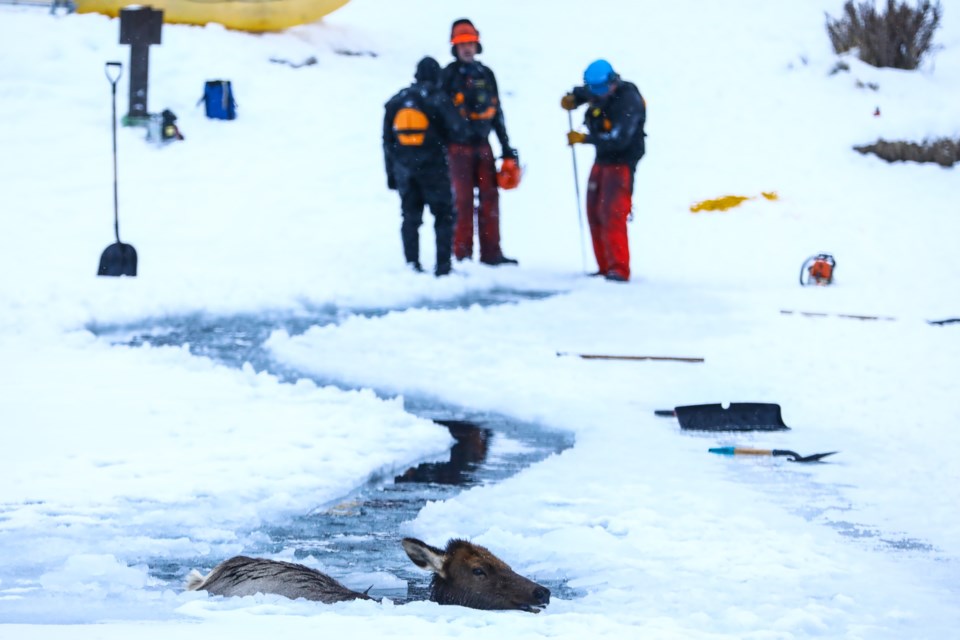BANFF – Parks Canada staff worked tirelessly for more than six hours to save a hypothermic cow elk they’d rescued earlier from the Bow River before it finally died.
A call came through to Banff dispatch on Wednesday (Jan. 6) at about 8 a.m. that a female elk had fallen through the ice into the river between Central Park and the Banff recreation grounds.
Wildlife experts were able to pull the elk from the river shortly before 10 a.m., and spent the next six-and-a-half hours trying to warm her with blankets and heaters on the shore by the rec grounds.
“We tried our best to get her up and going again,” said Blair Fyten, a human-wildlife management specialist with Banff National Park.
“We suspect she probably died of a cardiac arrest in the end.”
Because of the highly visible location where the elk fell through the river ice, wildlife experts made the decision to try to save the elk. When this happens out of view, or in a less busy and developed area in Banff National Park, they often let nature take its course.
Armed with equipment and safety gear such as a rubber boat, floating ladders, dry suits, chainsaws for cutting ice and special hand saws, resource conservation staff set about trying to get the animal out of the ice.
When staff first arrived, Fyten said the elk was buoyant and swimming around in the deep water.
“We are not really sure when she broke through the ice,” he said. “We suspect it was sometime during the night, so she could have been in there several hours before we got there.”
Before 10 a.m., staff had managed to cut a channel towards the riverbank on the south side of the Bow River, with a plan to haul her onto shore by the recreation grounds.
However, the 18-inch blades on the chainsaw couldn’t cut through the thick ice and the water was still very deep.
“We essentially brought her down the channel as close to shore as we could and got some ropes around her so we could pull her up onto the ice,” Fyten said.
“At this point in time, she was very weak and couldn’t stand.”
Rescuers managed to get the elk onto shore where they placed therm-a-rests beneath her, put blankets on top and secured her in a tarp to try to insulate her.
“We wrapped her up in a tarp just trying to warm her slowly so she could maintain what little body heat she might have had,” Fyten said.
“After several hours we just weren’t gaining a whole lot. She was conscious the whole time, but just never had the strength to try and stand; she was breathing normally, but her temperature was very low.”
At this point, Parks Canada staff put up a tent to try and make the elk even warmer.
“We got a propane heater and we able to blow warm air up into the space and blow some warm air on her underneath the blankets – and we were quite hopeful that we could warm her enough there,” Fyten said.
“There was a little bit of movement in her body trying to move her legs, lifting her head and flicking her ears, and we thought she was coming around a bit, but after six-and-a-half-hours she passed.”
This is not the first time that elk have fallen through the ice into the river in the townsite, including at this location.
Fyten said it sometimes happens in the backcountry and wildlife staff never know about it.
“Most of those times when it occurs in a backcountry area, we wouldn’t intervene,” he said.
In this instance, however, Fyten said the decision was made to try to rescue the elk because of concern that members of the public might try to rescue the stressed animal.
“It’s a highly visible area and it’s right on the edge of a path going across the river,” he said.
“It would be a public safety risk if somebody tried to go out there and tried to help or rescue this elk.”
Another concern is having a carcass in the river or stuck in the ice that could potentially attract carnivores like wolves.
“We wouldn’t want to have a carcass there and have carnivores coming in and feeding on it with people passing close by,” Fyten said.
In 2013, up to eight elk fell though the ice upstream of the canoe docks on the Bow River.
When grizzly bear No. 122, also known as The Boss, began to feast on the elk, Parks Canada closed off the area to the public.
“It was one we never would have located right away, but it was observed later and 122 had found it by then and was feeding on a carcass out in the river,” Fyten said.
“It was frozen into the ice there, but a portion of it was above the ice.”
Parks Canada encourages residents and visitors to report any wildlife that have fallen through the ice to Banff dispatch at 403-762-1470.
“Don’t try and rescue it yourselves,” Fyten said. “Let us know because we do have all the proper safety gear to work out on the ice and in thin ice conditions – and that way it doesn’t put the public at risk.”
The ice trail across the Bow River between Central Park and the Banff recreation grounds has now been closed off for safety reasons.
“The Town of Banff has put some barricades up either side indicating thin ice and you shouldn’t be crossing there,” Fyten said.




